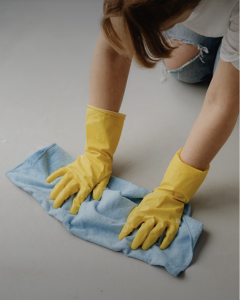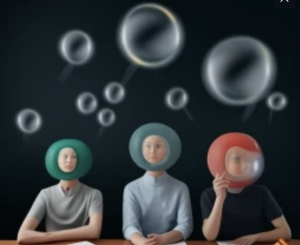When life gets hard and things go wrong, the most counterintuitive and seemingly impossible choice is to relax, to soften, and find ease with what’s happening. How can we (and why should we) relax when life feels out of control, and not in a good way? When difficulty arises, we fight with it, brace against it. Our resistance is our way of saying that we’re not okay with reality, and insisting that we can change it. But unfortunately, it doesn’t work and it doesn’t help.
These days, with four broken bones in my foot, I’ve taken to tooling around New York City on a knee scooter. As you might imagine, the ride is bumpy. My scooter is the opposite of a mountain bike; its wheels are petite and fragile and it takes nothing more than a twig or pebble to tip it over. I’ve gone flying numerous times, landing on my broken foot and in excruciating pain.
As I’ve gotten more skilled as a scooter pilot however, I’ve noticed something important about what makes for a hard ride and what makes it easier. It seems that the rougher the road, the more precarious my path, the tighter I tended to grip onto the handlebars, to tense my body and brace against the bouncing and jostling of the vehicle. The more turbulence I met, the more rigid I became in body and mind. As a result of the chronic bracing and constriction, I ended up with a spasming upper back and strained pectoral muscles, which made taking a deep breath an impossibility.
But I also noticed, thankfully, and just in time to trade in my scooter for my own feet, that if I opened my hands, loosened my grip just slightly when the bumps came, relaxed my upper body as the scooter tried to right itself in the uneven terrain, if I just allowed the bumping, tilting, and shaking to happen, remarkably, I didn’t tip over. The scooter adjusted and found its way back to smoothness without my having to mount a fight against it, and without my having to break anything else along the way.
In life, when the bumps come, when the road gets rough, as it has been for all of us of late, we tend to brace against it, fight with it, and try to control it. When we lose our job, the doctor calls with bad news, our marriage falls apart, or this gigantic bump, the pandemic arrives, we resist, brace, tense our minds and bodies, and (understandably) fight against what we don’t want. The more difficulty life delivers, the more unpredictability and impermanence, the tighter we grip onto what we know, what we have, an imaginary safety and permanence. We cling to an idea of what we had and what we’re losing. The more flexibility life demands, the more rigid we become, and the more we suffer.
When life throws us curveballs, or balls that hit us smack in the knee, we suffer not only from the pain of our smashed kneecap, but equally (if not more), from the thought that this shouldn’t be happening to us. We “shouldn’t” get hit in the knee, we don’t deserve that, this is not the life we signed up for. We get stuck in the idea of what our life “should” look like—which, for sure, is not this. We fight against reality, a reality, by the way, that has no interest in our protestations. article continues after advertisement
We not only brace against reality, cling onto an idea of how our life “should” be, but at the same time, we personalize the bumps in our path. We deny the truth, that everyone struggles and every human life includes difficulty, which means us too and our life. We reject the fact that we are not different from other humans, that we too will encounter bumps, and that this is indeed the human condition.
When difficulty arrives, we are temporarily shattered out of our uniqueness, out of our delusion that we are magically protected from hard times. But, we continue imagining that we are different and that our challenges are happening specifically to and against us. We feel punished, victimized, and personally deprived of what we deserve, burdened with difficulties that “shouldn’t” be, and that we “shouldn’t” have to endure. The result: We suffer more.
So, what does loosening our grip on the handlebars look like in real life? In reality, what does it mean to relax our body and mind, to allow the bumps in the road, ride through the chop without bracing against it, stay loose when the ground and we are shaking?
To begin with, it means that we stop fighting with the truth, stop bracing against what’s happening: the reality of the bumps. It means that we release the idea that this can’t be happening. Whether we want it or not, this is happening, this is our reality for now. The bumps in the road are here. That’s the inarguable truth, which doesn’t mean we like it or will stop doing what we can do to make it better. But the sooner we accept our reality, the sooner we can start adapting to it, righting ourselves within it.
More than anything else, we need to release this dangerous and damaging idea about the way our life “should” be going and what “should” be happening to us. We must see through this notion that our life is inherently different from all other lives and therefore, protected from pain. And, that we are somehow entitled to a life that is without big bumps.article continues after advertisement
To wish for a smooth and easy life, without great hardship, is natural and healthy, but to be tortured and feel punished by the fact that our life is like other lives, with its share of suffering and struggle, is to force ourselves to suffer senselessly and more than necessary. Human life includes hardship. You are human. You do the math.
So too, releasing our grip on the handlebars involves acceptance. This bump, this boulder, dragon, wildfire, or crevasse in our path, is not something we can control; it’s bigger than us. What it’s doing here, why the universe put it in our path, we don’t know and may never know. This involves that most profound step we call surrender. When we truly surrender to the fact that we cannot wish, work, buy, pray, seduce, or strategize this challenge away, that it’s here whether we want it or not, then, we are on our way to a smoother ride and a different sort of serenity.
Simultaneously, relaxing in the face of difficulty includes considering the possibility that there might something for us to learn from this bumpy path. While this broken pavement is a huge and scary obstacle now, perhaps something in all this turbulence can serve us later and help us grow. Perhaps something in all this difficulty and pain will help us be of service to others in some way at some time. While we can’t yet know what good might come from all this, staying open to this possibility, even when it seems unthinkable, can help us relax and roll with more ease. article continues after advertisement
As you roll through your life and encounter the bumps that every life contains, contemplate what it might mean to loosen your grip on the handlebars, to stop bracing against the ride. Ask yourself what that would look like in your own life. See if there’s a way to let go of the fight with reality, even when you absolutely despise your reality. Consider whether there’s anywhere or any way to relax with and within the reality that’s here, for now.
What’s certain is that when we brace against the challenges of life, fight with reality, reject our human vulnerability, rigidify our body and mind … when we do it that way, we strain other muscles, break other bones, and ultimately, we suffer, more than we have to. Counterintuitively, when we give ourselves the gift of relaxation, of softness, and acceptance; when we roll with not against our situation, we offer ourselves the smoothest ride possible on an inherently bumpy road. Strength and toughness are great skills, but it’s our ability to relax and roll when life gets hard that ultimately determines our resilience and wellbeing.


